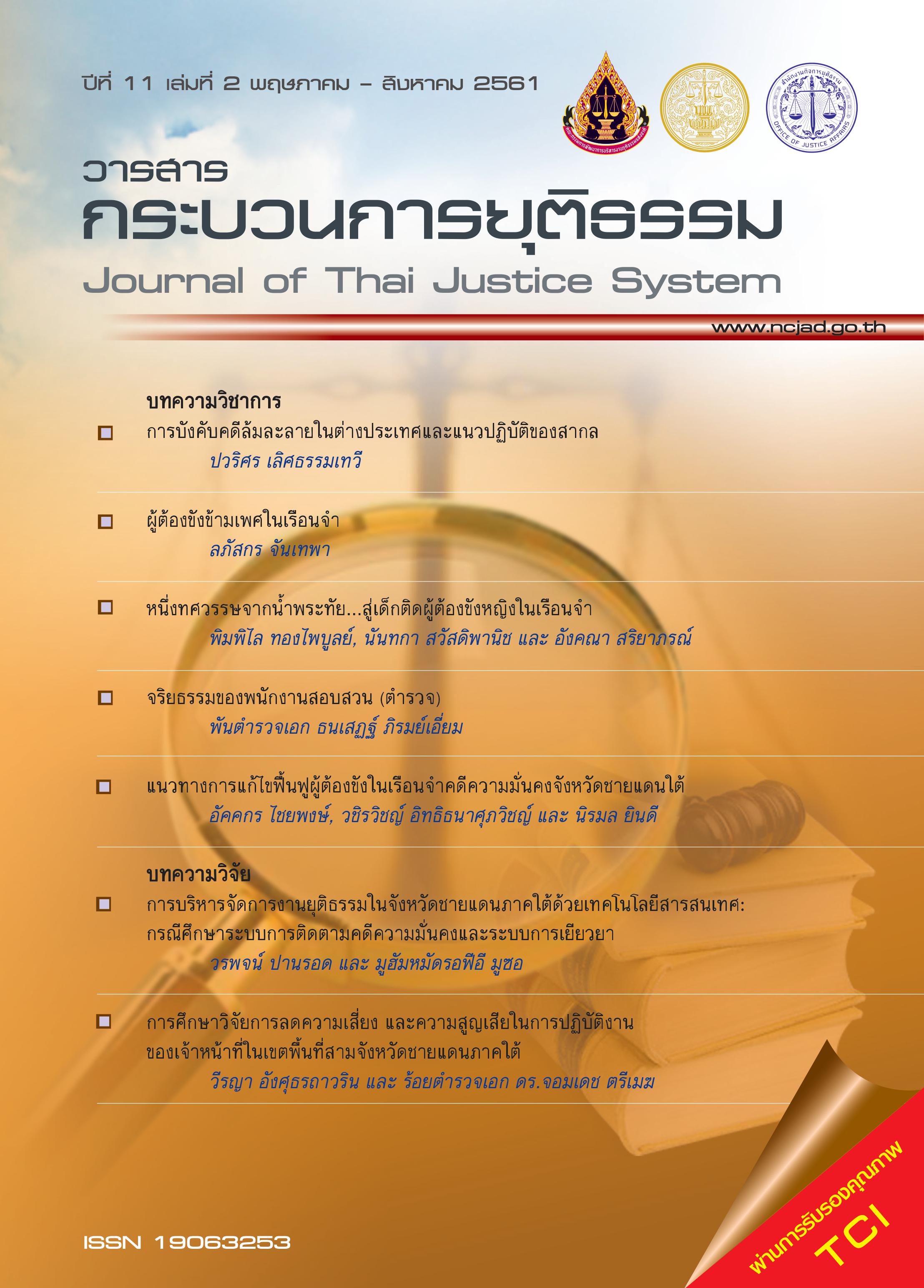แนวทางการแก้ไขฟื้นฟูผู้ต้องขังในเรือนจำคดีความมั่นคงจังหวัดชายแดนใต้
Main Article Content
บทคัดย่อ
แนวทางการแก้ไขฟื้นฟูผู้ต้องขังในเรือนจำคดีความมั่นคงจังหวัดชายแดนใต้ มีวัตถุประสงค์เพื่อศึกษาแนวทางการแก้ไขฟื้นฟูผู้ต้องขังในเรือนจำคดีความมั่นคงในพื้นที่จังหวัดชายแดนภาคใต้และเพื่อเสนอแนะแนวทางการแก้ไขฟื้นฟูผู้ต้องขังในเรือนจำคดีความมั่นคงในพื้นที่จังหวัดชายแดนภาคใต้ ทั้งนี้เพื่อประโยชน์แก่กรมราชทัณฑ์และผู้ต้องขัง พบว่า การยุติหรือลดบทบาทการเข้าไปเกี่ยวข้องกับคดีความมั่นคง ลดแนวคิดความรุนแรงและต้องการให้ผู้ต้องขังกลับคืนสู่สังคมและใช้ชีวิตอย่างปกติ ไม่หวนกลับไปกระทำผิดซ้ำ การแก้ไขฟื้นฟูผู้ต้องขังคดีความมั่นคงในเรือนจำจังหวัดชายแดนใต้จะต้องมีแนวทางแก้ไขฟื้นฟูผู้ต้องขังคดีความมั่นคงเป็นการเฉพาะ ซึ่งต่างจากคดีทั่วไปที่ใช้โปรแกรมพื้นฐานดังนี้ แนวทางที่ 1 การให้การศึกษาอบรมแก่ผู้ต้องขังคดีความมั่นคงในเรือนจำอย่างต่อเนื่อง เน้นการให้การศึกษาสามัญโดยเฉพาะ
การเรียนรู้ภาษาไทยและการฝึกวิชาชีพเพราะการศึกษาไม่ว่าจะเป็นวิชาสามัญหรือการฝึกอบรมวิชาชีพ จะสามารถเปลี่ยนทัศนคติของผู้ต้องขังได้ ส่วนการฝึกอบรมวิชาชีพควรมีความหลากหลายตามความสนใจของผู้ต้องขัง อีกทั้งเป็นการเพิ่มพูนความรู้ ทักษะและให้ผู้ต้องขังเรียนรู้เพื่อปรับตัวเข้าสู่สังคมภายนอกหลังจากพ้นโทษ แนวทางที่ 2 การให้คำปรึกษาทางจิตวิทยา ซึ่งเป็นแนวทางการแก้ไขฟื้นฟูผู้ต้องขังเป็นการเฉพาะมุ่งปรับเปลี่ยนทัศนคติและพฤติกรรมของผู้ต้องขัง โดยเฉพาะเพื่อลดความรุนแรง ละทิ้งความเชื่อผิด ๆ ซึ่งเป็นกระบวนการทางสังคมและจิตวิทยา แนวทางที่ 3 การให้ความรู้ทางศาสนาและการพัฒนาจิตวิญญาณเป็นการพัฒนาจิตใจโดยใช้ศาสนาเป็นเครื่องยึดเหนี่ยวจิตใจและจูงใจบุคคลให้กระทำความดี ละเว้นความชั่วเพราะศาสนามีอิทธิพลและมีบทบาทสำคัญยิ่งต่อการดำเนินชีวิต แนวทางที่ 4 การฝึกวิชาชีพการมุ่งเน้น เป็นเจ้าของกิจการ ไม่ว่าจะเป็นวิชาสามัญหรือการฝึกอบรมวิชาชีพจะสามารถเปลี่ยนทัศนคติของผู้ต้องขัง ได้และการฝึกวิชาชีพควรมีความหลากหลายตามความสนใจของผู้ต้องขังและให้ตรงกับวิชาชีพที่สังคมต้องการ เช่น การฝึกวิชาชีพด้านช่างยนต์ ช่างเชื่อม ช่างไฟ นอกจากนี้เรือนจำควรมีวิธีการสร้างการยอมรับจากสังคมและจากเจ้าของกิจการที่จะรับผู้ต้องขังเข้าไปทำงานภายหลังพ้นโทษ แนวทางที่ 5การมีปฏิสัมพันธ์และการมีส่วนร่วมของสังคมและครอบครัว ต้องจัดให้มีการเยี่ยมญาติอย่างใกล้ชิด มีกิจกรรมครอบครัว จัดให้มีผู้นำทางศาสนาเข้ามาทุกสัปดาห์ เพื่ออบรมให้ความรู้ รวมทั้งอำนวยความสะดวกในการปฏิบัติทางศาสนา เน้นการมีส่วนร่วมของผู้ต้องขัง แนวทางที่ 6 กิจกรรมด้านกีฬา นันทนาการ ดนตรีบำบัดและศิลปะเชิงสร้างสรรค์ให้กับผู้ต้องขังคดีความมั่นคงตามมาตรฐานขององค์การสหประชาชาติว่าด้วยการปฏิบัติต่อผู้ต้องขังและหลักสิทธิมนุษยชนโดยการจัดสวัสดิการด้านปัจจัย 4 และการสงเคราะห์ ในด้านอื่น ๆ ควบคู่ไปกับการเล่นดนตรี กีฬา การออกกำลังกายที่เป็นมาตรฐานเดียวกันทุกเรือนจำ
Article Details
ต้นฉบับที่ได้รับการตีพิมพ์ในวารสาร เป็นลิขสิทธิ์ของวารสารกระบวนการยุติธรรม แต่ความคิดเห็นที่ปรากฏในเนื้อหาของบทความในวารสารกระบวนการยุติธรรม ถือเป็นความรับผิดชอบของผู้เขียนแต่เพียงผู้เดียว
เอกสารอ้างอิง
นัทธี จิตสว่าง. (2546). โปรแกรมแก้ไขฟื้นฟูผู้กระทำความผิด. กรุงเทพฯ: โรงพิมพ์วัฒนพงศ์การพิมพ์.
มูลนิธิผสานวัฒนธรรม. (2553). กฎหมายความมั่นคง: หนทางแก้ไขความขัดแย้ง ศึกษากรณี 4 อำเภอจังหวัดสงขลาและ 3 จังหวัดชายแดนใต้. กรุงเทพฯ: เคล็ดไทย.
ฐานข้อมูลผู้ต้องขังคดีความมั่นคงจังหวัดชายแดนภาคใต้ ศูนย์ข่าวกรองและความมั่นคงกรมราชทัณฑ์.
(2559). จำนวนผู้ต้องขังคดีความมั่นคงจังหวัดชายแดนภาคใต้. [ออนไลน์] เข้าถึงข้อมูลวันที่ 13 ตุลาคม 2560. จาก http://www.correct.go.th/stathomepage/kmongkong.html.
อุททิศ แสนโกศิก. (2525). กฎหมายอาญา 1. กรุงเทพฯ: ศูนย์บริการเอกสารและวิชาการกองวิชาการ
กรมอัยการ.
ชาญเชาว์ ไชยานุกิจ. (2553). แนวทางการแก้ไขฟื้นฟูผู้ต้องขังคดีความมั่นคงในพื้นที่จังหวัดชายแดนภาคใต้ที่เหมาะสมโดยการมีส่วนร่วมของทุกภาคส่วนในสังคม. ไม่ระบุแหล่งที่พิมพ์


